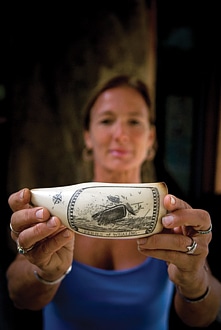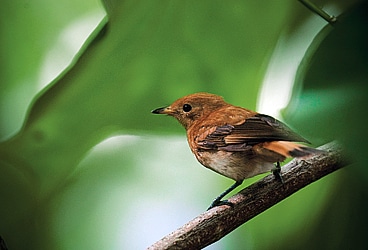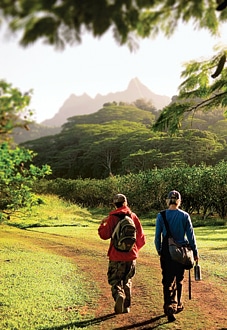Blue List: Voluntourism
What Is Voluntourism? Combining volunteer work with tourism creates voluntourism. It's a two-way bridge between you and an island's people and environment. Suddenly you're giving back, not just receiving, as you travel. The bonus: Most volunteers feel even more enriched by their travel experience because of the work they do. Whether you're interested in teaching children or caring for the elderly, promoting world peace, protecting newly hatched sea turtles or conducting archaeological digs, there's a voluntourism trip for you.
Global Volunteers on Rarotonga
The naturalist pauses on a narrow trail deep in the Takitumu Conservation Area and raises her hand for silence, like a soldier on point. Behind her, I and two members of Global Volunteers, a Minnesota-based nonprofit organization that lives up to its name, freeze and sweep our eyes across the creaking bamboo thickets and kingfern forest. We are high in the gullied ranges of Rarotonga, largest of the Cook Islands, enjoying what every tourist here enjoys — a morning trek into the cool mountains. But instead of just appreciating the emerald landscape and taking snapshots, we are trying to save from extinction an animal rarer than the mountain gorilla.
"They should be somewhere nearby," whispers Alison, the naturalist. She puts a finger across her lips and sucks in a loud, wet kissing sound.
"Well, don't just stand there," she says. "Start calling." So we smooch our sweaty fingers, sounding more like a bunch of lucky teenagers at the senior prom than aspiring conservationists.
Not surprisingly, we're skunked.
Each year, Global Volunteers sends out more than 200 teams to 21 countries. The participants, who pay a tax- deductible fee, offer their time and talents on a variety of projects, building schools and hiking trails, teaching English, even identifying whales. But this is no working vacation. Volunteers devote their days to the projects; evenings and weekends they're sea kayaking along the reefs, learning the local dances, drinking mai tais on the beach — living the dream.
I see that dream as I tag along with this Global Volunteers three-week program in the Cook Islands. I actually came to Rarotonga on a traditional trip with my family, but on this day, I've joined their mission: help Alison track the rare kakerori — a modern-day dodo.
Two thousand years ago, when Maori-speaking Polynesians first arrived here, they discovered a common forest bird and named it for its loud territorial call: tchee-kakerori. Stowaway rats made quick work of the kakeroris' nests and hatchlings. By 1989 there were only 29 birds left on the planet, all in three Rarotongan valleys.

Conservation efforts have brought the species back from the brink of extinction, but field surveys, an important conservation tool, are expensive. "It comes down to manpower," Alison says to our team of volunteers, young and old. "Bird censuses are time-consuming. You have to go and look."
One volunteer who's looking — without looking like a naturalist — is Evan, a teen from Toronto. Here in this exotic forest, he's dressed in parachute pants and a Quiksilver baseball cap. "I didn't volunteer for this," the self-described "city kid" says later as we eat lunch on a windy ridge with a 180-degree view of the wave-frothed reef below. "My mom volunteered the whole family."
His father has helped prepare a traditional double-hulled canoe for an ocean voyage to Samoa and worked in a local AIDS clinic; his mother and sister have prepared exhibits at the Cook Islands whale research center. "My favorite thing I've done so far is helping a college build its website," Evan tells me, citing his work at Tereora College on Rarotonga.
His experience was a two-way street: The college students taught him some island skills. "I've gotten pretty good at cracking open green coconuts, but I haven't drunk the juice yet," he says. "Find a way to carbonate it, and then maybe we'll talk."
I hear another volunteer, Sarah, laugh at that. She signed up for a Global Volunteers team in the Cook Islands when her plans to vacation in Spain fell through. "I wanted something different, a way to get more involved with the place," she says. During most of her time, she has been helping with a local preschool class. "You meet the families and feel very connected with the island. Rarotonga is so small, you get to know people. You make friends. The little children at school call me 'auntie.' It's a kind of experience you just can't get as a tourist. And besides, I work in the mornings, so every afternoon I can ride my bike around the island or head to the beach."
We finish lunch, and the wind picks up, the smell of rain drifting in from the sea. We're barely back on the trail when Alison stops and points at a shadow within a shadow. "There's one!" she shouts.
A rusty bird the size of a robin cocks its head from a nearby fern frond. "See if it has a leg band," Alison whispers. Evan pops out a Canon point-and-shoot and snaps away. "No leg band," he announces, scrolling through digital images and zooming in on the bird's scaly legs. And then the kakerori dissolves in a blur of wings. There are smiles all around. "I'm not really into birds," Evan says as he shows Alison the rest of his pictures, "but that was really cool."

Back with my wife and young daughter on our last day on Rarotonga, we run into Evan and his family at the Punanga Nui Market, where tourists handle souvenir statues of the sea god Tangaroa and order fresh smoothies from women in straw hats. As we talk , practically every passing local tosses out a cheery "Kia orana!" to Evan's family.
I feel a pang of envy. We'd been on Rarotonga almost as long as Evan and the other volunteers. My family and I had had a wonderful time as tourists. But the volunteers were the cool kids. And searching for a kakerori or teaching a preschool class was just the icing on the cake.
What volunteering had given them was a behind-the-scenes pass to Rarotonga. People knew their names, were inviting them to parties and had tipped them off to the best beaches. And they don't look weary. They look relaxed, even serene. As Evan and his family fade into the crowd, I wonder just how old my daughter has to be before I can volunteer my own family. globalvolunteers.org
Voluntourism: More Winners In addition to our featured trip detailed above, ISLANDS recommends these trips from our 2009 Blue List, which also represent the best in sustainable travel.
Azafady Pioneer, MadagascarWork with a small grassroots nonprofit tackling conservation issues and extreme poverty in Madagascar. Take part in a range of construction work, conservation research and educational activities ranging from the building of wells and schools in remote villages to teaching English and planting trees. Participants should be prepared for physical work in a hot climate, adventurous road journeys and long walks to reach remote and beautiful project sites. madagascar.co.uk
Volunteers For Peace, HaitiVFP's Haiti efforts arise at the local level, when particular communities express needs. Work with VFP's partner, the NEGES Foundation, in its efforts to create a botanical garden with medicinal herbs and to educate locals about natural remedies, health and ecology. You'll help sustain long-term agricultural projects, which will feed people for years to come. vfp.org
Biosphere Expeditions, AzoresSpend your days on a 45-foot catamaran, photographing and recording whales and dolphins in an archipelago that's said to be home to 30 percent of the world's known cetacean species. Biosphere Expeditions team members also track loggerhead turtles, collect sperm whale skin samples for DNA analysis, and snorkel to whale dive points. At night in the comfortable eco-lodge, discuss the day's findings with supervising scientists. biosphere-expeditions.org
Global Vision International, Moso Island, VanuatuJoin forces with GVI and the inhabitants of Tasiriki village on Moso island in a long-term turtle nesting survey started in 2006. In the dark of night, patrol local beaches to tag and monitor turtles. During the day, cook local food & snorkel to your heart's content. gvi.co.uk
Earthwatch Institute, Easter IslandSearch for prehistoric dwellings, earth ovens, gardens and livestock enclosures. Uncover clues to the ancient mystery of Rapa Nui's giant stone moai. Take an archaeological tour of Rano Raraku crater, participate in field excavations and laboratory studies, and further explore the island on a horseback tour of the rocky coast. earthwatch.org
